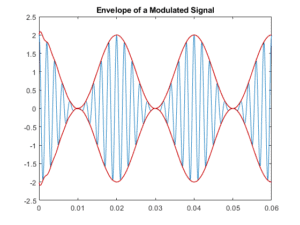1. Overview
The well-known Fourier transform is widely used in analyzing the frequency content of signals. For example, the Fourier transform makes it possible to filter signals based on their frequency content using frequency-selective filters.
The Hilbert transform, on the other hand, provides another method for filtering signals based on their phase content, i.e., phase selectivity.
In this tutorial, we’ll briefly discuss the Hilbert transform and its applications.
2. Definitions
The Hilbert transform of a function g(t) is defined as:
is the Hilbert transform of g(t). Obviously, the Hilbert transform is the convolution of g(t) with the time function
. Since convolution in the time domain corresponds to multiplication in the frequency domain, we may express the Fourier transform of
as:
-jsgn(f) and G(f) are the Fourier transforms of and g(t), respectively. j is the imaginary unit, i.e.,
, and sgn(f) is the signum function in the frequency domain:
Therefore, the Hilbert transform shifts the phase of all the positive frequencies of a signal g(t) by -90 degrees and the phase of all the negative frequencies by +90 degrees. However, it doesn’t affect the amplitudes.
The inverse Hilbert transform, which recovers the original signal g(t) from , is defined as:
The Hilbert transform has several useful properties. For example, the Hilbert transform of is -g(t), i.e., applying the Hilbert transform twice to a signal results in multiplying the signal by -1.
3. Applications
The Hilbert transform is widely used in signal processing and telecommunications.
It’s useful in obtaining an analytical signal, which has no negative frequency components. For example, we define the pre-envelope of a real-valued signal g(t) as:
The real part of the pre-envelope is the signal g(t) and the imaginary part is the Hilbert transform of the signal,
.
One common application of the Hilbert transform is in the single-sideband modulation (SSB). SSB is a special form of amplitude modulation (AM) and double-sideband suppressed-carrier modulation (DSBSC). These modulation techniques require a transmission bandwidth equal to twice the original baseband signal. However, SSB can send either the lower or upper sideband of the modulated signal. Therefore, the required bandwidth is equal to the bandwidth of the baseband signal we want to transmit.
An SSB-modulated signal consists of the summation of the baseband signal and its Hilbert transform, but both are modulated onto a carrier frequency. The signal corresponds to either the upper or lower sideband of the SSB modulation.
The magnitude of an analytical signal corresponds to the envelope of the original signal. Therefore, another application of the Hilbert transform is using it as an envelope detector. Here’s an example of envelope detection:

The blue signal is a modulated cosine wave, whereas the envelopes are in red. The envelopes correspond to the amplitude of the signal’s Hilbert transform.
The Hilbert transform also provides the mathematical basis for representing passband signals. A passband signal has its frequency spectrum centered around a specific frequency. The Hilbert transform of a passband signal provides another signal shifted in phase by 90 degrees.
Besides signal processing and telecommunications, the Hilbert transform has applications in diverse fields like image processing, sonar, radar, seismology, and biomedical signal processing.
4. Conclusion
In this article, we briefly discussed the Hilbert transform and its applications. First, we learned the definition of the Hilbert transform. We saw that it shifts the positive frequencies of a signal by -90 degrees and the negative frequencies by +90 degrees.
Then, we mentioned its applications. We saw that it plays an important role in SSB and provides the mathematical basis of passband signals. It’s also used in the envelope detection of signals.